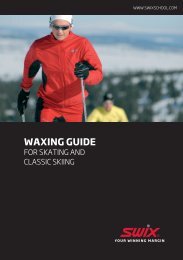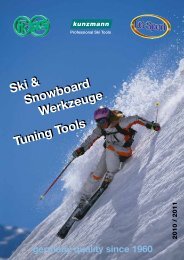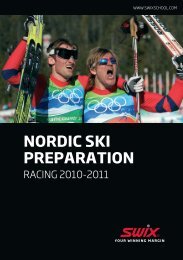ALPINE SKI & SNOWBOARD PREPARATION
ALPINE SKI & SNOWBOARD PREPARATION
ALPINE SKI & SNOWBOARD PREPARATION
You also want an ePaper? Increase the reach of your titles
YUMPU automatically turns print PDFs into web optimized ePapers that Google loves.
SAFETY RECOMMENDATIONS<br />
• Wax room ventilation. Make the extra effort to see that the area where<br />
you work on skis has exhaust fans and fresh air supply. Race organizers<br />
usually give the location for working on race equipment too low a priority,<br />
and often the waxing areas have little or no ventilation.<br />
• Do not expose waxes to open flames such as from a waxing torch, heat<br />
guns, space heaters, fire places, etc. Do not smoke cigarettes while waxing<br />
with fluorocarbon or fluorinated hydrocarbon waxes. In fact, don’t<br />
smoke at all! There is a chemical danger associated with fluorocarbon<br />
waxes when they are overheated. If fluorocarbon waxes are exposed to<br />
a heat source having a temperature higher than approximately 300°C<br />
(570°F), the fluorocarbon material disintegrates developing a poisonous<br />
gas. Normal iron temperatures will not cause a harmful breakdown of<br />
Swix waxes.<br />
• When using power brushes for brushing waxes a substantial amount of<br />
wax “dust” particles occur. To prevent inhalation of the particles use a<br />
“particle” mask. This can be the paper-type used in wood working.<br />
• Use safety glasses when power brushing.<br />
• If you question the quality of the waxes you are using, or feel that your<br />
exposure amount to waxing is extensive, use a respirator mask. It should<br />
be a cartridge type for filtering organic vapors. This type of mask is important<br />
to use when doing base repair with a burning polyethylene repair<br />
candle or base welder.<br />
• Be aware of the type of base cleaner you are using. Have good ventilation.<br />
And dispose of the rags or Fiberlene properly.<br />
• The addition of fluorocarbon materials into the hardwaxes and klisters<br />
means they must not be exposed to open flames of any type.<br />
Waxing torches should not be used for application or removal of fluorinated<br />
kick waxes. During application the warming-in of the wax with an<br />
iron is acceptable. Use a solvent for removal.<br />
Category 1:<br />
100% Fluorocarbon<br />
Cera F Solid Turbo<br />
The Solid versions of Cera F Powder are 100% fluorocarbon<br />
powder pressed under very high pressure<br />
into solid 20 g. blocks. In addition, they contain<br />
the BD solid lubricant additive. The purpose<br />
of the solid forms of Cera F is for on-hill, rub-on<br />
application when it is not possible to return to the<br />
indoor waxing rooms when competitions require<br />
more than one run.<br />
1: Rub on a thin even layer.<br />
2: Cork into the base with the Swix Natural Cork<br />
(T20).<br />
3: Brush the base with the Swix Blue Nylon Brush<br />
(T160).<br />
Cera F Solid can also be ironed on. See application<br />
steps for Cera F Solid.<br />
FC7WS - Cera F Solid “Cold Turbo”<br />
100% fluorocarbon solid block of wax.<br />
Temperature range from 0°C to -20°C. For transformed/man<br />
made snow. Used alone or as the<br />
final “accelerator” layer.<br />
FC8WS - Solid White Uni Turbo<br />
100% fluorocarbon solid block of wax.<br />
Temperature range from +4°C to -4°C.<br />
For fine grained snow. For clean white snow covering<br />
most normal winter conditions. Wide range.<br />
Used alone or as the final “accelerator” layer.<br />
FC10BS - Solid Wet Turbo<br />
100% fluorocarbon solid block of wax.<br />
Temperature range from 0°C/+20°C.<br />
For wet/polluted/coarse snow. The black lubricant<br />
additive has positive effect in polluted snow. Used<br />
alone or as the final “accelerator” layer.<br />
24 25





